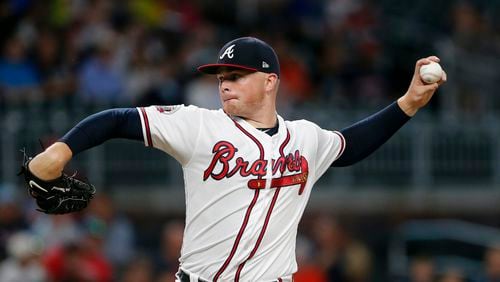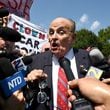Braves lefty pitching prospect Sean Newcomb walked too many batters in Triple-A. seems logical he will walk even more in the big leagues. Major league hitters may not know his tendencies but that’s more than offset by their superior talent and plate discipline.
But it hasn’t worked out that way so far for Newcomb, who is walking a substantially lower percentage of batters than he did at Triple-A Gwinnett. The sample size is small—-Newcomb is scheduled to make his fourth start for the Braves Tuesday at San Diego—but the early results are encouraging and surprising.
The stakes are higher in the majors, where there is more pressure to perform. But Newcomb, 24, said those factors have helped him improve his command.
“Most of the time whenever I really have to buckle down I just get more aggressive and it works a little bit better,” Newcomb said. “I guess just being on a bigger stage, every pitch matters now rather than maybe having those down moments in the minors.”
Newcomb has walked seven of the 73 batters he’s faced in the majors for a 9.6 walk percentage. In 11 starts at Gwinnett Newcomb walked 33 of 249 batters faced for a 13.2 walk percentage.
Is it really possible that the jump in competition has helped Newcomb improve his command?
“Sometimes that is a factor,” Braves catcher Tyler Flowers said. “He is focused on executing whatever pitch is called. Who knows? Maybe down there he was trying to think more along with the scouting reports. He’s not Greg Maddux or anything but he’s got an idea to get it to the different quadrants that you need to get it to.”
It will take many more starts to get enough data to make any real conclusions about Newcomb’s true ability as a major league pitcher. But his good command early in his career is not insignificant because it tends to be an indication of
A study by Scott Van Lanten of FanGraphs concluded that the three strongest statistical predictors of future success for young major league pitchers are strikeout rate, fastball velocity and strikeout rate minus walk rate. Pitchers who strike out a lot of batters and walk fewer keep the ball out of play and runners off the bases, thus decreasing the role of defense and luck in their results.
A good sign for Newcomb is that he posted a high strikeout percentage at every level of the minor leagues. His average fastball velocity, reportedly as high as 94 mph in the minor leagues, has been 93.1 mph during his major league starts according to Pitch f/x data.
Those are all positive signs for Newcomb, who was ranked the No. 78 prospect by Baseball America before this season. There also are some caveats.
So far Newcomb is not piling up a lot of strikeouts in the majors: a 17.8 strikeout percentage compared to 29.7 percent at Gwinnett. That’s one reason his Fielding Independent Pitching measure, which excludes the effect of defense on performance, is 3.57 compared to his 1.96 ERA.
Also, major league hitters will adjust once they see more video of Newcomb and face him more times. Up until now he hasn’t suffered the statistical “penalty” that typically happens for pitchers when they face a batting order for the third time in a game.
To help offset that inevitable development, Newcomb said he is working to refine his change-up to go along with his curveball and slider. He said that’s the only technical change he’s making for now.
“Nothing I’m too worried about,” Newcomb said. “Just worried about maintaining that command and staying here (in the majors).”







